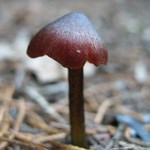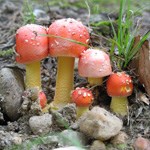
In a Inventory of Macrofungi of four other National Park Service units near the nation's capital, Prince William Forest Park yielded more specimens than any other park. Especially notable were the abundant and diverse Amanita, Boletus, and Russula. These fungi are large and colorful, making them likely to attract attention from visitors. The Little Run Loop Trail, Farms to Forest Trail, and the South Valley Trail all included abundant and diverse fungi, with different taxa in each area. Here are just a few of the many types of mushrooms and fungi that you can find in Prince William Forest Park. 
NPS photo American Caesar, Amanita caesareaWhile American Caesar, or Caesar's Amanita, has a somewhat shiny reddish cap, yellowish gills and a saclike cup at the base of the stalk. It can be usually found from late July through October in dry forests of oak and pine. It is edible, but like most mushrooms, should never be eaten in the wild without an expert. There are many poisonous lookalikes. 
NPS photo Liberty Cap, Psilocybe semilanceataThe Liberty cap is a hallucinogenic mushroom that grows on grassy meadows and particularly in wet, north-facing fields. The consumption of this mushroom has been outlawed. It is widely distributed through North America but is most common in the Pacific northwest. 
NPS credit Fly Agaric, Amanita muscariaThe fly agaric is generally common and numerous where it grows. The fruiting bodies emerge from the soil looking like en egg. As the mushroom grows it changes in shape and in color. The cap changes from a spherical shape to a more plate-like, flat shape as it matures. The white color begins to fade away as the red begins to show through. Meadow Mushroom, Agaricus campestrisThe meadow mushroom is widely collected and eaten, even by those who don’t normally experiment with mushrooming. This mushroom is not commercially cultivated on account of its fast maturing and short shelf-life it is closely related to the button mushroom. This species has many look alikes, including the destroying angel (morbidly toxic), the yellow stainer (gastrointestinal problems), and the horse mushroom. Destroying Angel, Amanita virosaAmanita virosa are highly poisonous mushrooms. Symptoms from a poisoning from this mushroom include vomiting, diarrhea, and cramps. Liver and kidney dysfunction follow, and without treatment, will lead to death. Destroying angel grows in mixed hard wood forest throughout North America. This is a white mushroom with ragged rings on stalk and a large, saclike cup about base. Chestnut BlightThe American chestnut was very prolific in this area in the early 1900s. They were valued both for their lumber and for their nuts. In 1904, a Chinese chestnut was brought from Asia and planted in the Bronx Zoo. At that time, no one knew the Chinese chestnut carried with it a fungus known today as the chestnut blight. If you are lucky, you may still find a American chestnut in the woods today. Often, they die right after they reproduce when the tree is at its weakest. Dutch Elm DiseaseLike the Chestnut Blight, Dutch Elm Disease was accidentally brought to the United States from the Netherlands in 1928. Dutch Elm disease is generally transported three different ways: by beetles, by humans who use a saw to cut down a effected elm and then go and use the same saw to prune a healthy tree, and finally by the ability to move through the roots system to attack new and healthy trees. AnthracnoseAnthracnose is a widespread fungal disease throughout the Eastern United States. The most common symptom of this disease is dead areas or blotchy leaves. The diseases are sometimes called leaf blight, because of the brown, scorched appearance of the leaves. The most common trees susceptible to anthracnose are ash, basswood, birch, catalpa, elm, hickory, maple, oak, sycamore, yellow poplar, and walnut. |
Last updated: June 29, 2022
